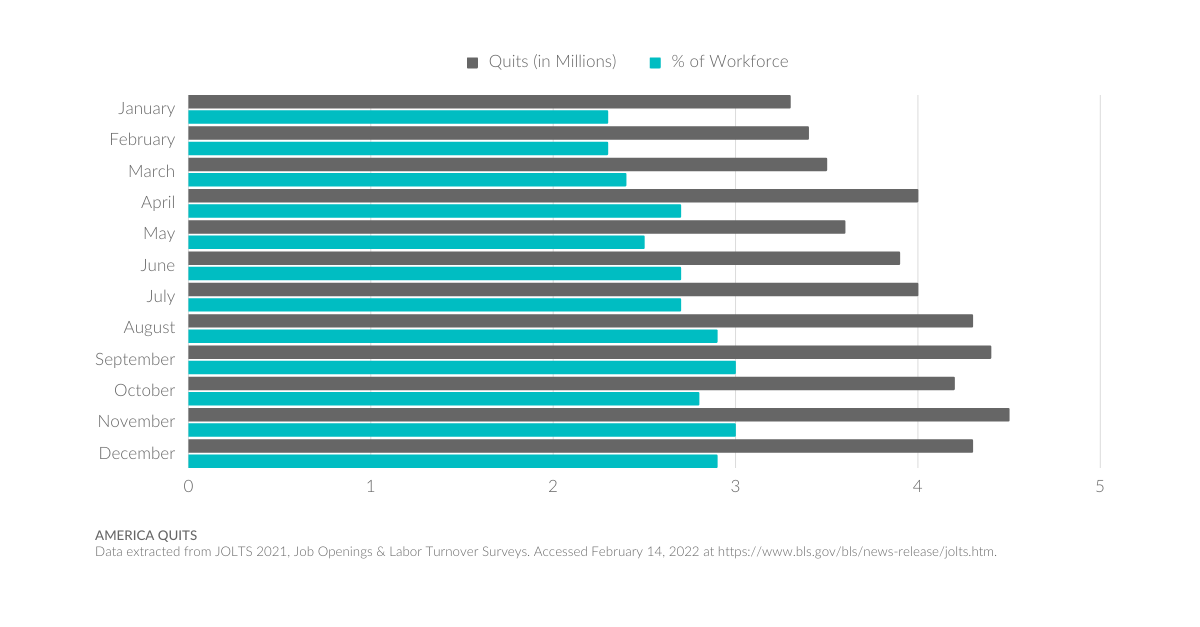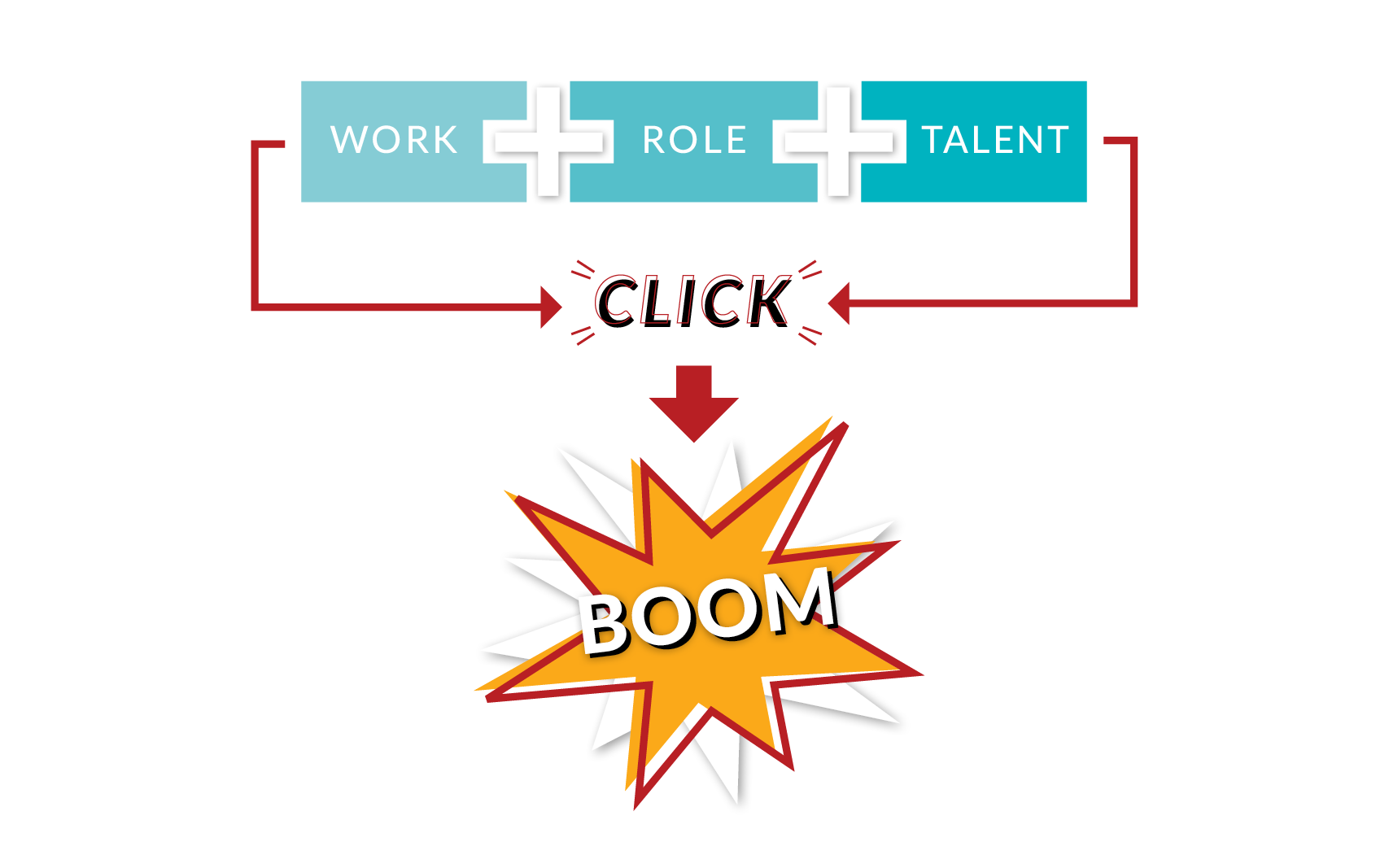The Great Resignation is not all about the pandemic. COVID just accelerated what was already happening in our workplaces.
You have probably heard that 47.4 million Americans quit their jobs in 2021. Theories abound as to what may be behind the trend associate professor Anthony Klotz at Texas A&M University dubbed this “Great Resignation.” Many have cited COVID-related burnout for healthcare and knowledge workers; lax health and safety standards and exploitative, abusive managers for rage quitters. Some point to notable CEOs and their leadership teams, exhausted from the gut-wrenching toll of the last two years, stepping out of the fray to leave it to someone else to drive the recovery of their businesses. Others mention the lure of better working conditions and higher pay for service workers and the promise of early retirement for financially secure Boomers. What I don’t hear people talking about is the fact that in 2019—before COVID—the United States government (which has only been tracking resignations since 2000, by the way) was already noticing a record high quit rate.
It is not just the pandemic that is driving this trend. Something is missing in the world of work these days. I propose that something is “click.”

The Great Reflection
After being thrust into lockdown in March 2020, I took time to reflect on what I was doing and how I was doing it. (Interestingly, so did 74% of LinkedIn survey participants who admitted they similarly reevaluated their work situation while working remotely.1) One key insight came out of my great reflection.
Life is short. I want to spend the rest of mine on things that produce what I call "click."
For me, “click” happens when three things line up perfectly. First, there’s an identifiable chunk of work that I want to get done in a specific situation. Second, it is clear what my role will be as I’m doing the work. And third, I am ready, willing, and able to apply my talent to the work in context. When all three literally “click” into place, it’s almost as if the energy of the whole thing explodes with a loud “Boom!” I’ve seen magic happen for me and the people I’m working with and for when that occurs.
Unfortunately, I’ve also seen that, for many people, all too often, it’s “no click, no boom.” This has left me with a great sensitivity and appreciation for what can be going on with others.

From “No Click” to “UnClick”
It’s this “no click” that, I suspect, had Microsoft report that 41% of 30,000 workers in 30 countries considered switching their jobs due to burnout, dissatisfaction, fear for their personal safety, or a shift in priorities.2 In my role as an HR leader, I’ve seen many different permutations of “no click” situations that graduate to “unclicks.”
Sometimes the problem lies with the work itself; sometimes with the design of the role; sometimes with the readiness of the talent to do the work in the role.
Not all work is created equal. Some is just plain harder. Work that has never been done before and that is really new for the organization can be particularly difficult. The person doing such work must create new relationships, invent new processes, and establish new organizational patterns and habits. An urgent demand for innovation, combined with the time it takes to enroll people in change, can, and sometimes does, make this a “mission impossible.” Some people love to take on these missions, even though the work is not accomplishable. However, it’s better from the perspective of the business to provide work that, while it may stretch the person and have them grow, is still achievable.
Not all roles are set up to win. Some roles, especially those focused on work that is new and “alien” to the enterprise, may encounter significant noncooperation, if not outright opposition, within the organization. Even if the work is not new or difficult, the role itself can still be destined for failure. Some roles are designed without the authority they should have. Others are created without appropriately planned resources. Yet others will encounter inherent conflict with other roles in the organization. Any of these aspects of the role design—whether they occur either individually or in combination—can create resistance that makes it challenging to get things done. And assembling a poorly designed role on top of demanding work can be the perfect set-up for frustration and burnout.
Not all talent is ready. Readiness is not about good talent versus bad talent. It is about skill and confidence, commitment, and motivation. It is about a person being able and willing to do the work of the role in the situation in which it that work must be done. Unfortunately, it is common practice to put someone into a role for which they are not ready and/or ask them to do work for which they are not ready. If the ask is too big and the person cannot or will not close the gap in time, both they and the organization lose.
You are in a “no click” situation if the work is challenging, the role isn’t designed properly, or if you are not ready to accomplish it in context. Continue in one of these situations long enough and you will likely either be asked to unclick or you will unclick yourself.
Nobody wins with unclick. The company can lose the value you would deliver and you could lose your dignity.
This applies to individuals at every level of an organization. If you are like most people, you want opportunity, responsibility, and mobility. You don’t want struggle. In that light, the decision to unclick yourself from a poorly designed role or a no-win situation makes sense. (The Great Resignation is the loud “unclick” happening everywhere these days.) Fortunately, unclicking offers you a great opportunity: the chance to explore other situations in which you can create your own “click.”
The Great Opportunity
In theory, every job has the potential to be a good one. But what makes a job “good”? I believe it’s the whole “role, talent, click, boom” thing I talked about earlier—with “click” being the catalyst for success.
Creating “click” is a matter of exploring the work to be done, being involved in the design of the role, and making yourself ready for your dream job. Now that you are aware of its importance, you can ask yourself three questions when you are looking at a new opportunity:
- What is the work to be done?
- What is the design of the role—and can I be involved in that design?
- Am I ready to do this work in this situation? (That is, do I have the skill and the confidence, the commitment and the motivation to do it in context?)
Understand that the responsibility for “click” does not rest with you alone. The leaders of the company who are looking to hire you share that responsibility, no matter where your next role sits in their organization. This brings me to the great opportunity I see for companies in all this.
By focusing on improving “click”, business leaders can also demonstrate they really do care about their people. Such a focus takes into account the context in which work must be done. That situational awareness can smooth out workloads and rethink tasks that are unimportant or irrelevant. It can literally transform our workplaces so more and more people are able to be “productive, empowered, and customer-focused”, as Zeynep Ton, MIT professor and president of the non-profit Good Jobs Institute says.3
What I have seen so far is that when leaders care enough to focus on “click”, things get a lot better for everyone. And when things get a lot better for us all, fewer are likely to want to quit.
1 Kumar Keshaw. “Post-Pandemic Pitfall: The Great Resignation”. LinkedIn, August 27, 2021. Accessed November 5, 2021, at https://www.linkedin.com/pulse/post-pandemic-pitfall-great-resignation-2021-kumar-keshaw/?trk=articles_directory.
2 “The Next Great Disruption is Hybrid Work: Are We Ready?”, 2021 Work Trend Index: Annual Report. Microsoft, March 22, 2021, p. 23. Accessed April 7, 2021, at https://www.microsoft.com/en-us/worklab/work-trend-index/hybrid-work.
3Zeynep Ton, “The Good Jobs Solution”, Harvard Business Review, November 2017, pp. 4 and 6. Accessed April 12, 2022, at https://goodjobsinstitute.org/wp-content/uploads/2018/03/Good-Jobs-Solution-Full-Report.pdf.

